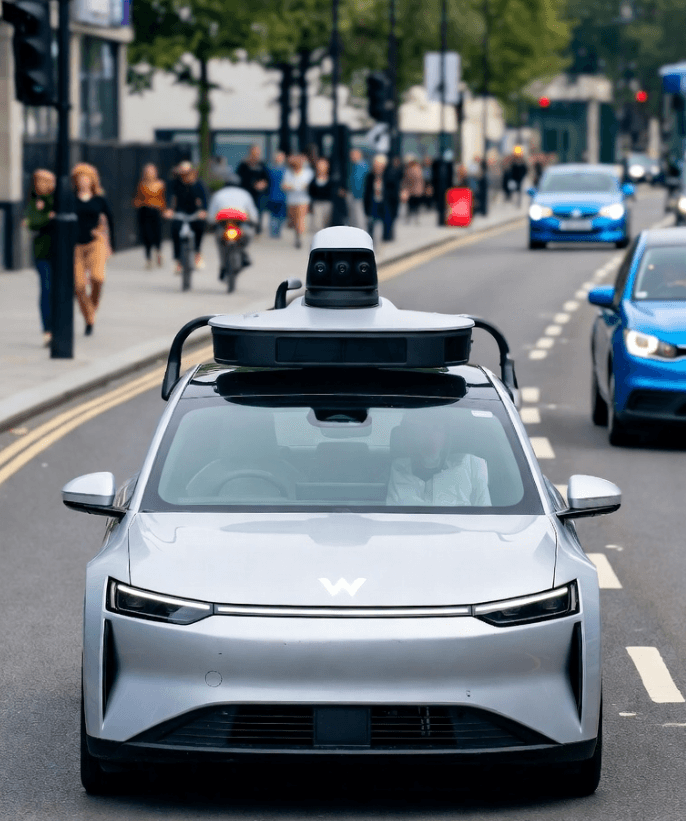London’s streets are busy and unpredictable. Waymo, a subsidiary of Alphabet, plans to introduce autonomous taxis in the city by 2026. These taxis already operate in U.S. cities such as San Francisco, Austin, and Atlanta, safely navigating traffic and picking up passengers. However, London presents unique challenges. Streets are narrow, intersections are complex, and pedestrians, cyclists, and taxi drivers often behave unpredictably. Technology alone may not be enough to ensure safe operations.
London traffic is not only dense but also culturally distinct. Black cab drivers often weave through lanes quickly, while students or nightlife crowds may place temporary obstacles or pull pranks on streets. Even small distractions or pranks can affect the safe operation of autonomous vehicles. This shows that despite advanced sensors and AI, autonomous vehicles must still manage the unpredictability of human behavior.
The Role of Millimeter-Wave Radar
Autonomous taxis rely on multiple sensors, among which millimeter-wave (mmWave) radar is one of the most important. It emits high-frequency radio waves to measure the distance, speed, and movement of surrounding objects. This radar works reliably in rain, fog, or low-light conditions, whereas ordinary cameras may perform poorly. Data from the radar is sent to the vehicle’s computing system, which decides when to slow down, brake, or change lanes. According to IEEE Spectrum, mmWave radar is highly effective at detecting small moving objects that cameras might miss.
The radar’s advantages go beyond range and accuracy. It measures the speed and direction of moving objects in real time. This allows the vehicle to anticipate potential hazards and adjust its path smoothly. For example, if a cyclist suddenly moves from the sidewalk into the road, the radar can detect them early, and the AI system can coordinate braking or evasive maneuvers.
The Uniqueness of London Traffic
London’s traffic environment differs significantly from American cities. Streets are narrower, historical districts rarely follow straight layouts, and intersections are often dense. During peak hours, there are many pedestrians and cyclists, and vehicles frequently weave through traffic. Even experienced local drivers must constantly adapt. For autonomous vehicles, this increases the complexity of perception and decision-making.
Beyond ordinary traffic, human unpredictability is a challenge. For instance, university students leaving late-night events may place temporary obstacles, or people may film pranks for social media. Although these actions are occasional, they can affect autonomous driving. mmWave radar can detect obstacles and stop the vehicle, but it cannot anticipate human intent. This highlights the importance of public education and clear regulations.
Lessons from Other Cities
Waymo’s operations in U.S. cities offer useful lessons. The vehicles handle busy traffic, obey traffic lights, yield to pedestrians, and avoid collisions. Still, humans sometimes act unexpectedly. Pedestrians may cross roads suddenly, and vehicles may change lanes without warning. London streets are narrower and more crowded, creating higher complexity. Deploying mmWave radar-equipped taxis in London will provide valuable data to improve sensor performance, enhance AI prediction models, and develop safe operational protocols.
Linpowave Millimeter-Wave Radar Solutions
Linpowave is a leading company in mmWave radar technology, focusing on autonomous vehicles and smart city applications. Their sensors detect moving and stationary objects with high precision, even in crowded environments or adverse weather conditions. Sensor data feeds AI systems, which determine the taxi’s speed, lane choices, and emergency responses.
Linpowave radar is not limited to autonomous taxis. It can also be applied to traffic management and industrial safety systems. For example, radar can monitor traffic flow, detect vehicles violating rules, or identify moving obstacles in industrial sites, improving overall safety and efficiency. This demonstrates the broad utility of mmWave radar technology.
The Importance of Human Behavior
Even with radar and AI, human behavior is critical. Drivers, pedestrians, and cyclists must follow traffic rules, and cities must educate the public about how autonomous vehicles operate. This reduces conflicts and accidents. Radar helps vehicles respond safely to sudden situations, but predictable human actions remain essential.
Real-World Scenarios
Millimeter-wave radar is useful in various scenarios:
-
Busy Streets: In crowded shopping areas, vehicles can detect many pedestrians and adjust speed and path.
-
Sudden Obstacles: A shopping cart, construction barrier, or fallen object can appear suddenly. Radar detects it early, allowing the vehicle to brake or maneuver safely.
-
Pranks or Temporary Obstacles: Occasional pranks may create minor disruptions. Radar ensures the vehicle stops safely, but rules and public awareness are necessary.
-
Adverse Weather: Fog, rain, or low light does not compromise radar detection, maintaining continuous awareness of the environment.
These scenarios illustrate that mmWave radar is not only a technical tool but also a key safety component for autonomous taxis operating in unpredictable human environments.
Frequently Asked Questions (FAQ)
Q1: What is millimeter-wave radar?
A: Millimeter-wave radar uses high-frequency radio waves to measure the distance, speed, and movement of nearby objects. It works reliably in rain, fog, and low-light conditions and complements cameras and lidar (IEEE Spectrum).
Q2: How does mmWave radar help autonomous taxis?
A: It provides real-time obstacle detection, enabling vehicles to react safely and reduce collision risk.
Q3: Are autonomous taxis safe in London?
A: Safety depends on both technology and human behavior. Radar enhances situational awareness, but people must act predictably.
Q4: Where can I learn more about mmWave radar solutions?
A: Linpowave offers mmWave radar applications for autonomous vehicles, smart cities, and industrial systems.
Q5: When will Waymo launch taxis in London?
A: Waymo plans to start operations in 2026, pending regulatory approval and pilot testing results.



